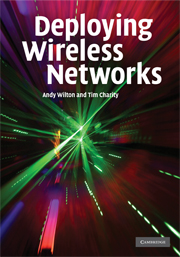Book contents
- Frontmatter
- Contents
- Foreword by Sir David Brown, FREng
- Preface
- Acknowledgements
- Authors' disclaimer
- 1 Introduction
- 2 Wireless network systems
- 3 Principles of access network planning
- 4 Introduction to RAN planning and design
- 5 GSM RAN planning and design
- 6 UMTS RAN planning and design
- 7 Cellular OFDM RAN planning and design
- 8 Mesh network planning and design
- 9 Core network and transmission
- 10 Network operation and optimisation
- Acronyms
- Index
- References
1 - Introduction
Published online by Cambridge University Press: 13 August 2009
- Frontmatter
- Contents
- Foreword by Sir David Brown, FREng
- Preface
- Acknowledgements
- Authors' disclaimer
- 1 Introduction
- 2 Wireless network systems
- 3 Principles of access network planning
- 4 Introduction to RAN planning and design
- 5 GSM RAN planning and design
- 6 UMTS RAN planning and design
- 7 Cellular OFDM RAN planning and design
- 8 Mesh network planning and design
- 9 Core network and transmission
- 10 Network operation and optimisation
- Acronyms
- Index
- References
Summary
The human species is unique amongst all life forms in developing a sophisticated and rich means of communication speech. While communication may have had its origins in the need for individuals to work co-operatively to survive, it is now deeply embedded in the human psyche and is motivated as much by social as business needs. Historically, this was met simply as individuals with similar interests and values chose to form small settlements or villages and all communication was face to face. It was not until the introduction of the telephone in the late nineteenth century that social and business networks could be sustained even when the individuals concerned did not live in the vicinity. Although the coverage and level of automation of the fixed telephony network improved dramatically over the next 100 years, the next major step, communication on the move, was only possible with the introduction of wireless networks.
The term ‘wireless network’ is very broad and, at various points in history, could have included everything from Marconi's first transatlantic communication in 1901, the first truly mobile (tactical) networks, in the form of the Motorola walkie-talkie in use during the Second World War, to the wide-area private mobile networks in use by the emergency services and large companies since the late 1940s. However, ‘wireless networks’ didn't really enter the public consciousness until the commercial deployment of cellular mobile radio in the 1980s.
Information
- Type
- Chapter
- Information
- Deploying Wireless Networks , pp. 1 - 9Publisher: Cambridge University PressPrint publication year: 2008
